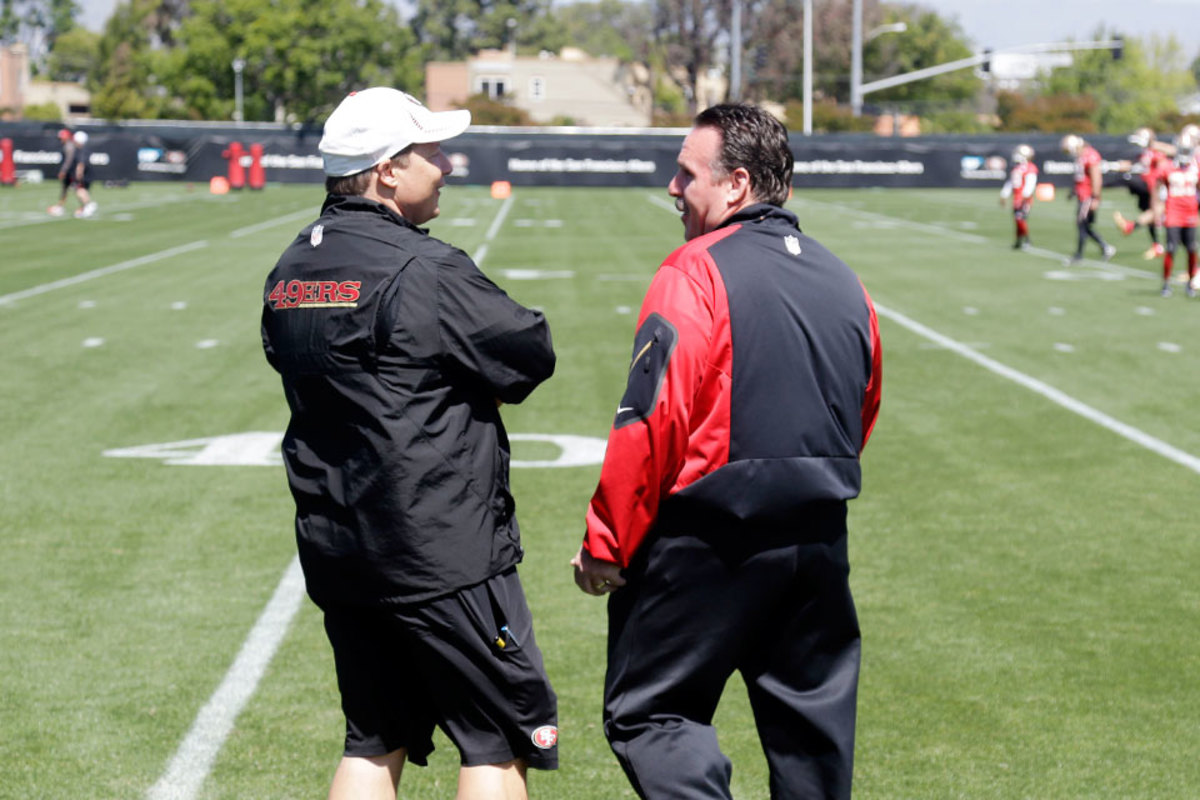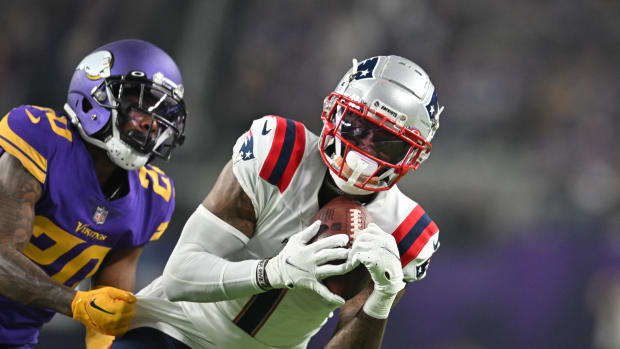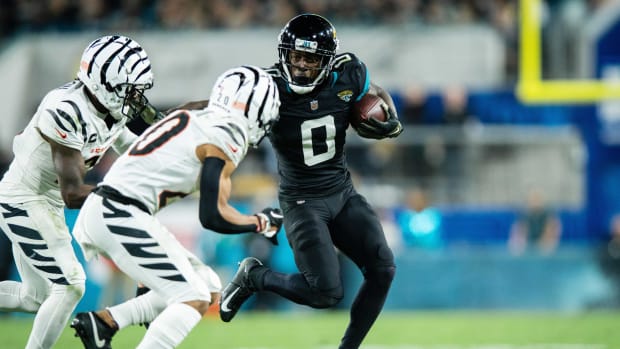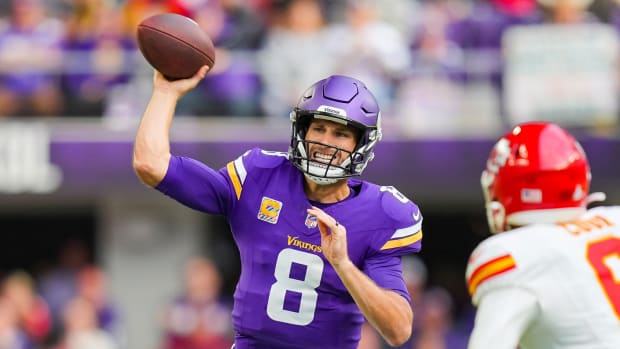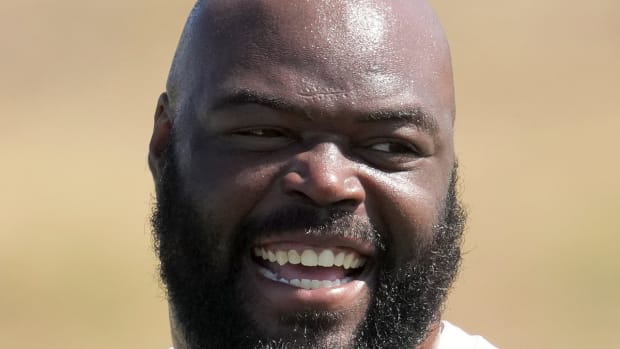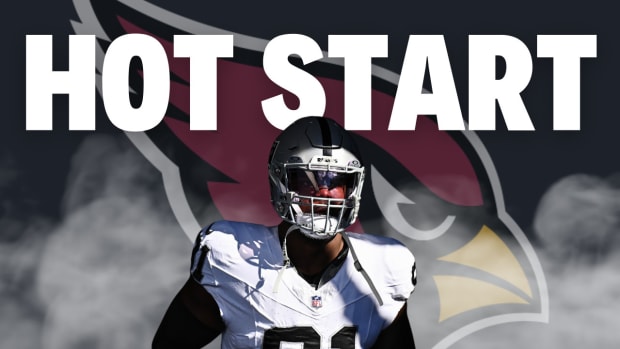Mangini in the Middle
Eric Mangini was a defensive coordinator at age 34, a first-time head coach at 35 and fired from his second head-coaching gig at 39. Where do you go from there? For Mangini, the answer was working his way back into the NFL as a senior offensive consultant for the 49ers in 2013—a chance to work on the other side of the ball—followed by a season as San Francisco’s tight ends coach. Now, a decade after his first coordinator job, with the Patriots, he’s returned to that seat again as the Niners’ defensive coordinator under new coach Jim Tomsula. After the team’s veteran minicamp, Mangini talked to The MMQB about what his experiences have taught him and about how he’s retooling a defense that lost stalwarts Patrick Willis and Justin Smith and rising star Chris Borland all in one offseason.
VRENTAS: Before Jim Tomsula asked you to be his defensive coordinator, had you given any thought to returning to the role soon?
MANGINI: Yeah, it was something I wanted to do. When I came to San Francisco, just in talking to Jim [Harbaugh] about the [offensive consultant] job, I thought it would be really interesting to spend some time on offense, to sit in the meetings, to be able to sit in the booth, to go through the game-planning, to see and hear what caused problems from the other side, and challenge myself by doing something I hadn’t done in 15 years. I started on offense in Cleveland and Baltimore, but it had been a while. That was the thought process. Also, the idea of coaching the tight ends last year—that was out of my comfort zone, but I thought it would be great experience for when I did go back to defense. And it has been.
VRENTAS: What’s something you learned from being part of offensive game-planning that will help you on the other side of the ball?
MANGINI: It’s interesting, when you sit in the meetings and talk about the running game or talk about protections, to hear how some things defensively create problems for the offense. It may be the shade of a defensive lineman, how much of a problem a slight shade can create, and how much of a conversation that can create for the offense. It’s really not that big a deal to us on defense, but it’s really interesting to hear what a big deal it is to you on offense. Thinking back to those meetings, I was making sure, when I go back to defense, that we create those conversations for opposing coaches.
The MMQB 100
Introducing The MMQB’s ranking of the most influential figures for the 2015 season. THE LIST SO FARNos. 71-80: Like Winston and Mariota last year, Michigan State’s Connor Cook, the presumptive 2016 top QB prospect, will loom over the NFL season. Plus, Jimmy Haslam, Colin Kaepernick, Todd Gurley and more. FULL STORYNos. 81-90: After a crushing NFC title game loss, Mike McCarthy takes on a different role. Plus Jim Harbaugh, Khalil Mack, Eli Manning and more. FULL STORYNos. 91-100: Rachel Nichols is a thorn in Roger Goodell’s side. Plus, Richie Incognito, Le’veon Bell, John Elway and more. FULL STORY
VRENTAS: It’s been a decade since you’ve been a defensive coordinator. What about the job is different now from what it was in 2005?
MANGINI: The offseason is pretty different, because with the new rules, in the first part of the program you can’t actually have any routes run against you. You can’t have any plays run against you. And so much of defense is adjustments and then reaction. We could get the adjustment component with a walkthrough, but you couldn’t go through with the guys and take that time and teach pattern reads with routes or teach the fits in the run game. All that had to be from tape.
The typical offseason program in the past gave you a lot more time leading into OTAs to get things the way you want to see them and to teach at a slower tempo. This year we went from adjustments to competition against the offense in OTAs. While the offense can run its routes, run its plays, and they’ve all got designed spots based on the calls, we didn’t have any of that until OTAs. That was interesting—that transition from walkthrough to reaction.
VRENTAS: How do you respond as a coordinator when your defense loses Willis, Justin Smith and Borland all to retirement in the same offseason?
MANGINI: As much as there have been guys who have retired or left for whatever reason, we also have a lot of guys coming back from injuries. NaVorro Bowman [torn knee ligaments in January 2014] is back. So are Ian Williams [minor leg fracture in November last season] and Glenn Dorsey [missed 2014 with a torn biceps]. So there are quality players who weren’t part of last year’s defense in a significant way or who missed significant time. Those guys are coming back, which is great. That gets a little bit lost in the whole conversation.
VRENTAS: How have you melded your defensive playbook between your ideas, the system Vic Fangio ran with this team last season, Tomsula’s ideas, etc.?
MANGINI: I have always seen playbooks the same way: It’s a living, breathing thing that evolves each year. Every time some new ideas come into the system, they become part of our playbook, the 49ers playbook. It was the same thing when I was in New England [as defensive backs coach beginning in 2000]. We did things a certain way, then Rob Ryan came into the system and we incorporated elements of the 46 and things that were from that family tree. We did the same thing here. We have three other guys on the staff [Tim Lewis, Clancy Pendergast and Jason Tarver] who were former NFL defensive coordinators. During the offseason we looked at the calls we had, the ways we wanted to play, and talked about how we wanted to play the different calls to get the answer we thought best fit us.
From my perspective, it’s good because you hear so many different ideas, and all those guys have been coordinators and have had to deal with the problems of the job. So they’ve got great perspective. Why did you do it this way, and why did you find it to be effective? We have great conversations, saying, I think this is the best way to go, let’s see how it works, and if not, we can default to this way. On a lot of staffs, only one person has been a coordinator, and there are younger guys who are just position coaches, so you don’t necessarily get the same infusion of ideas.
VRENTAS: Your head coach is also a defensive guy. Will you call the defensive plays?
MANGINI: Yeah, I’ll call the plays. There’s always the head coach’s prerogative, just like I had when I was head coach. There are certain things he wants at a certain time, and that’s no problem.
VRENTAS: How has your defensive philosophy changed since the last time you were a coordinator?
MANGINI: Drawing from the experience of the past two years, and bringing that in. Being on offense, I got to watch a lot of defense. Every week I was watching defensive tape. It was a good look at trends in the league, the things that are effective, and that’s another part of the evolution of the playbook. Things become in vogue offensively. I remember when empty formations first came out. That was the rage, and then you had the Wildcat quarterback, and then you had the Pistol. On defense it was the zone blitz that Pittsburgh started back in the day, and then press quarters. There are always different systems that come in, both offensively and defensively, and become a trend. My general defensive philosophy—to be flexible enough to react to whatever we have to deal with, to having a solid core we can always default back to—is still in place. And then you hear about being game-plan specific. Sometimes that’s just a catch phrase, but I grew up that way defensively, and I believe in that, where each week we are going to have challenges we have to deal with, and we have to have the tools and flexibility both physically and mentally to get that done in a very short time frame. So I’m a big believer in building flexibility into the defense, too.
Talking Football
Jenny Vrentas’s in-depth interviews: Ike Taylor in retirement.Shane Vereen on Tom Brady.Byron Maxwell, the Eagle.Len Dawson, Chiefs legend.THE FULL SERIES
VRENTAS: What trends did you observe while studying opposing defenses the past two years?
MANGINI: Typically what happens is, whoever wins the Super Bowl, people will emulate that defense. Seattle has had an impact on a lot of teams around the league with the things they do. We saw them twice a year, and they do what they do really well. There are definitely huge advantages to some of the stuff they do. You won’t necessarily adopt that, but you adopt elements of that. There are other teams that are really effective at blitzing and creating pressure, and you look at it and say, What makes them effective, what do they do well, what’s been the biggest challenge for offenses that face them? Let’s see if we can take components of that and do that well.
VRENTAS: You have had an interesting career arc in that you were a head coach at a very young age and now you are working your way back up again. How have you reinvented yourself as a coach the past few years?
MANGINI: Nothing really prepares you for that experience of being a head coach. You go through and make a ton of mistakes, and you learn from your mistakes, and you take the time to sit back and say, OK, when I get the next opportunity, what do I want to do differently? It’s also a function of watching other coaches. I got a chance to see the way Jim Harbaugh coached, and to see how Jim Tomsula is approaching it. You take different things away from it. It really is like anything else—when you see ideas work that are different from what you’ve been raised on, you start to incorporate those into your approach and philosophy. At the end of the day, though, the biggest thing I’ve learned is you’ve just got to do things that fit your personality, your voice, and be authentic.
VRENTAS: Are you hoping to be a head coach again?
MANGINI: I think that’s every coach’s eventual goal is to do that. That’s definitely something I’d want to do again.
VRENTAS: How have you tried to be a resource to Jim as he navigates being a first-time head coach?
MANGINI: The biggest goal I have is to try to keep problems off his plate when I can. I know as a head coach I always appreciated coaches who limited the amount of problems I had to deal with on a daily basis. That has huge value. He has so many things on his plate and so many different areas that need his time and attention. I want to make sure my area isn’t one of them. If I can help in any way or provide insight in any way, that’s what I am going to do. But outside of that, I’m not going to try to push any philosophies or approaches that I had. It’s more important to just be there to help him in whatever way he needs on whatever time frame he needs it.
VRENTAS: How would you describe your vision for the 49ers defense this season?
MANGINI: Ideally, it’s sound, disciplined, tough, physical, aggressive and smart.
Follow The MMQB on Facebook, Twitter and Instagram.
[widget widget_name="SI Newsletter Widget”]
































